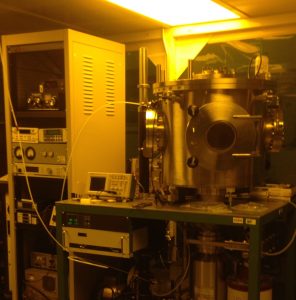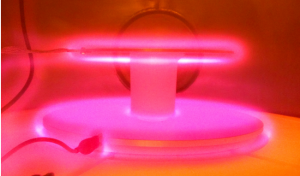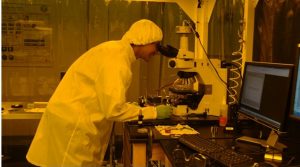Physics 452 (known as “Senior Lab” by Physics majors at NC State) is designed to give students experience with the use of modern electronic instrumentation, rigorous data reduction methods, and scientific writing. The Education and Research Laboratory plays an increasingly important role in hosting some of the most active and rewarding projects available to Senior Lab participants. Examples of Senior Lab projects or sub-projects carried out in EaRL are:
Plasma Experiment
 Vacuum Chamber
Vacuum Chamber
A large-volume plasma chamber is available for students to investigate the electrical properties of plasmas. Students gain valuable experience with operating high vacuum systems, professional radio-frequency power supplies, and measurement systems. Projects using this equipment are flexible, and students are encouraged to follow their own research direction.
 Plasma
Plasma
Brownian Motion
A large-volume plasma chamber is available for students to investigate the electrical properties of plasmas. Students gain valuable experience with operating high vacuum systems, professional radio-frequency power supplies, and measurement systems. Projects using this equipment are flexible, and students are encouraged to follow their own research direction.
 Graduate Student Carlos Ortiz
Graduate Student Carlos Ortiz
Prof. Robert Riehn has designed and currently advises students on a project where they observe and quantify the Brownian motion of submicron sized polystyrene beads. Students prepare a very thin solution of beads confined between glass slides and then observe their motion with Nixon 80i Fluorescence microscope. Both preparation and characterization is carried out in EaRL cleanroom facility.
Thin Film Growth
 Graduate Student Michael Roman
Graduate Student Michael Roman
Several senior lab experiments require thermal evaporation of thin metal films. Students studying surface plasmon resonance in ultrathin metal films need to prepare fresh thin Al coating on their 90 degree prism. This is carried out in the thermal evaporator in EaRL under the supervision of graduate student Mike Roman. The atomic force microscopy experiment also requires thin film samples.
Atomic Force Microscopy
 Senior Lab Students
Senior Lab Students
Students who choose Atomic Force Microscopy (AFM) for one of their independent projects have considerable freedom to decide the materials they investigate with EaRL’s research quality Asylum MFP-3D instrument. Examples include thickness-dependent studies of the morphology of Al films grown by thermal evaporation in vacuum. A recent and very interesting study saw students prepare anthracene single crystals and then monitor their slow degradation over several weeks with AFM as shown in the sequence to the right.

